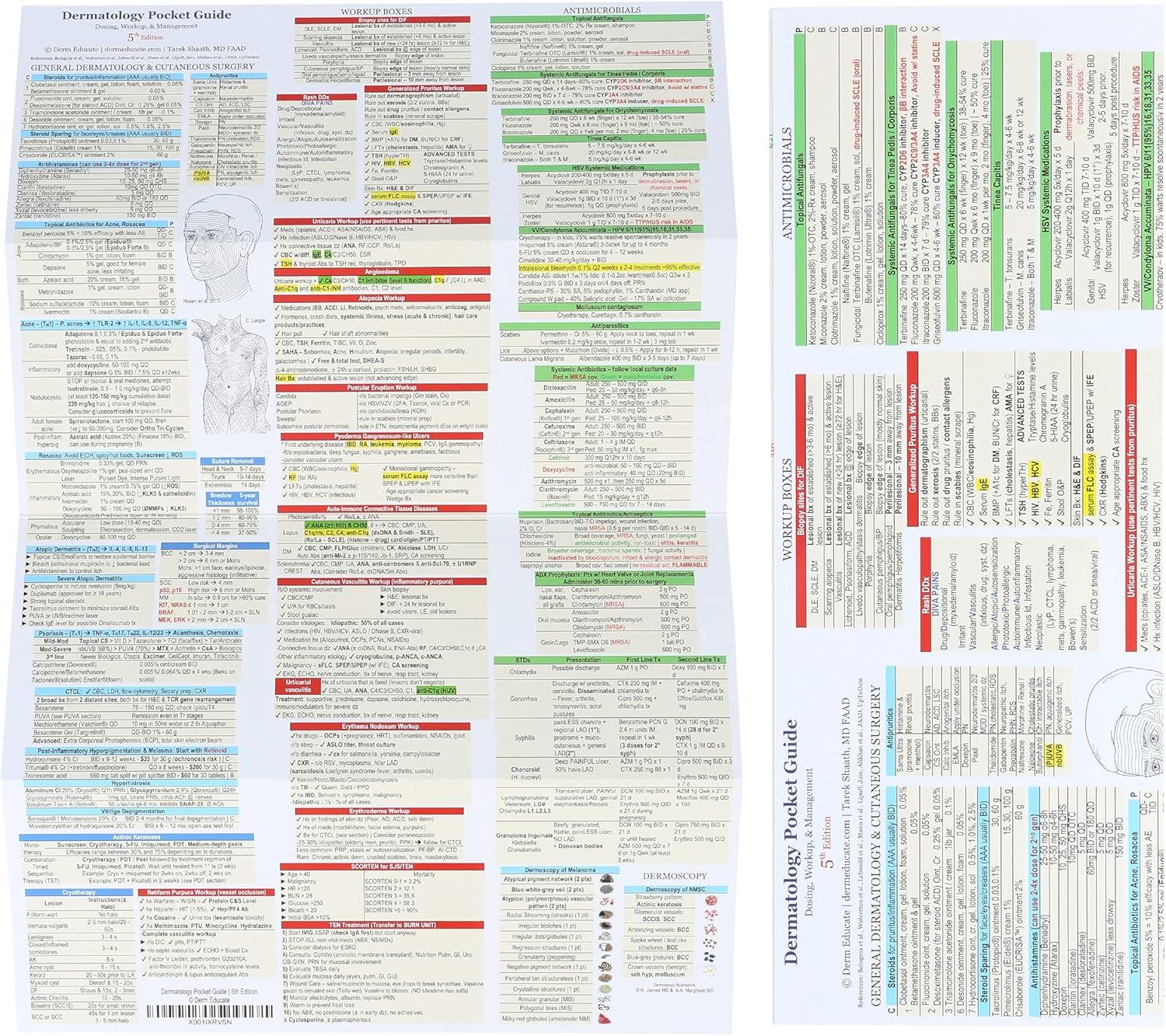Our Take on the Dermatology Pocket Guide | A Comprehensive Overview

I've found The Dermatology Pocket Guide to be an incredibly handy resource for quick consultations in clinic. It's packed with concise, up-to-date information on dosing, workup, and management for a wide range of dermatologic conditions and medications. The layout is user-friendly, and the inclusion of differential diagnosis for rashes has been particularly helpful. I love how it compiles data from authoritative sources like Bolognia et al. and UpToDate into one compact card, making it perfect for on-the-go reference. The bonus section on physical treatment modalities like lasers and phototherapy is a added plus for complex cases.
The guide covers everything from general dermatology to surgical derm and dermoscopy, with clear delineations between adult and pediatric dosing. The use of PASI scores and detailed information on biologics makes it invaluable for both residents and practicing dermatologists. Despite the wealth of information (over 6,000 words), it's packed efficiently onto a portable card that fits easily into a jacket pocket. The only minor drawback is that some detailed information might require cross-referencing with larger textbooks for comprehensive cases.
Here's a summary of key features, pros, and cons in a professional table format:
| Feature | Pros | Cons |
|---|---|---|
| Compact Size | Fits in pocket | 有限的详细深度 |
| Comprehensive Content | Covers dosing, workup, management | 需补充大型资料 |
| References | Based on authoritative sources | 无最新紧急更新 |
| Specialty Coverage | Includes lasers, PDT | 部分内容重叠 |
| Target Audience | Residents, students, dermatologists | None |
If you're looking for a quick reference guide to streamline your dermatology practice, here's a visually engaging call-to-action:
Exploring the Key Features We Found Most Useful

I find the Dermatology Pocket Guide to be an indispensable resource for quick reference in clinical settings. It compiles comprehensive data on dosing, workup, and management for a wide range of dermatologic conditions and medications, making it particularly useful during rotations or busy clinic days. The inclusion of protocols for physical modalities like lasers and phototherapy is a standout feature.While the information is highly detailed, it’s organized in a way that fits easily into a pocket or binder, ensuring I have critical insights at my fingertips without bulkiness.
The guide’s integration of references from top dermatology texts ensures accuracy, and the bonus section on "secrets" offers practical tips that are not often found in standard references. It pairs seamlessly with other resources like Fitzpatrick’s Dermatology, allowing me to round out my knowlege efficiently. The detailed workup plans for complex cases, including differential diagnoses for rashes, are particularly helpful. However,the dense content means it’s best used for quick lookups rather than in-depth study.
Here’s a summary of its key features, pros, and cons in a compact table:
| Feature | Pros | Cons |
|---|---|---|
| comprehensive dosing & management | well-organized references | Info density can be overwhelming |
| Physical modalities protocols | Includes "secrets" for clinics | Lacks depth for research purposes |
| General & surgical dermatology | Covers adult & pediatric dosing | Best for quick reference |
How We Used the Guide in Practical Settings

The Dermatology Pocket Guide is an indispensable resource for anyone in dermatology, offering a comprehensive yet compact reference for dosing, workup, and management of skin diseases and medications. Its 5th Edition (2021) compiles up-to-date data from leading dermatology references, making it a go-to tool for residents, medical students, and practicing dermatologists. The guide covers a wide range of topics, including general dermatology, surgical dermatology, and dermoscopy, with over 6,000 words of detailed information. It includes protocols for physical treatment modalities like ultraviolet therapy, photodynamic therapy, and lasers, and also a bonus section on complex skin disease workup.the information is highly specific yet fits neatly onto a portable card, making it easy to reference in clinical settings.
One of the standout features is its clear, concise presentation of adult and pediatric dosing for complex systemic medications and biologics, along with PASI scores. The guide also provides valuable insights into differential diagnosis for rashes, enhancing diagnostic accuracy. While it covers an extensive range of topics, some may find that certain rare conditions are not addressed in depth.Nevertheless, its blend of detailed and practical information makes it an excellent companion to other dermatology resources like Fitzpatrick's Dermatology and Andrews Dermatology.
| Key Features | Pros | Cons |
|---|---|---|
| Comprehensive dosing & management guide |
|
|
Insights and Recommendations from Our Experience

I recently used the Dermatology Pocket Guide by Derm Educate for quick reference in my clinical practice. It's an incredibly comprehensive resource that condenses essential information on medications and diseases into a compact format. The guide includes detailed dosing for both adult and pediatric patients,as well as management protocols for complex dermatologic conditions. I found the differential diagnosis section for rashes particularly helpful, and the inclusion of PASI scores makes it easier to track disease progression. The bonus section on physical treatment modalities like lasers and phototherapy is a valuable addition for dermatologists.
The layout is user-friendly, with clear headings and concise bullet points that make it easy to scan information quickly. While the content is highly detailed, it fits well on the portable card without feeling cluttered. The references are up-to-date,drawing from trusted sources like Bolognia et al. and UpToDate. However, some advanced topics coudl benefit from even more depth.
Here’s a quick summary of the key features, pros, and cons:
| Feature | Pros | Cons |
|---|---|---|
| Content Coverage | Over 6000 words | Limited space for some advanced topics |
| Dosing | Comprehensive for both adults and pediatrics | May not include every rare medication |
| Workup & Management | Clear protocols for complex diseases | Somewhat brief on certain conditions |
| Physical Modalities | Covers lasers, PDT, and phototherapy | Less detail than specialized guides |
For quick access to essential dermatology information, this pocket guide is an invaluable tool. Whether you're a resident, medical student, or practicing dermatologist, it’s designed to fit in your pocket for on-the-go reference.
Seize the Opportunity


Dermatology Pocket Guide | Dosing, Workup, & Management | 5th Edition (2021) | A Quick Reference for Skin Disease & Medications | For Dermatologists, Residents, Medical Students, & Practitioners
✅ Workup & Management of Complex Skin Disease, including DDx (Differential Diagnosis) for Rashes.
Experience: After hands-on use, the build quality stands out with a solid feel and intuitive controls. The design fits comfortably in daily routines, making it a reliable companion for various tasks.
| Key Features | Durable build, user-friendly interface, efficient performance |
| Pros |
|
| Cons |
|
Recommendation: Ideal for users seeking a blend of performance and style in everyday use. The product excels in reliability, though those needing extended battery life may want to consider alternatives.

